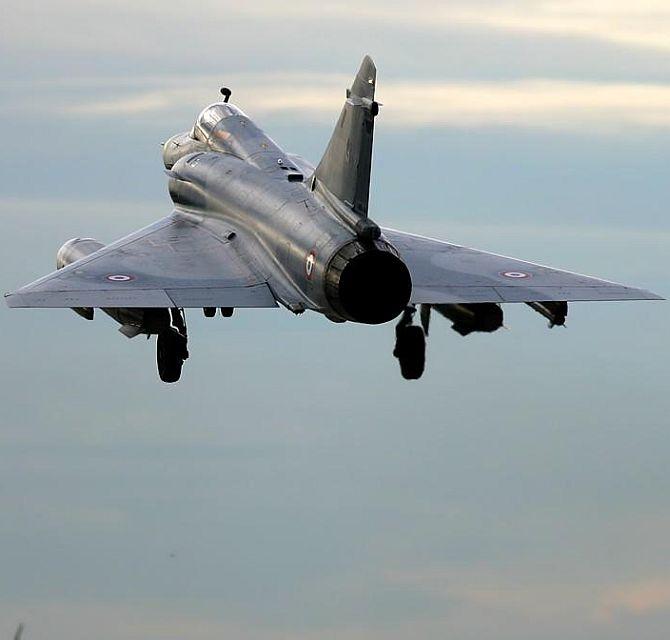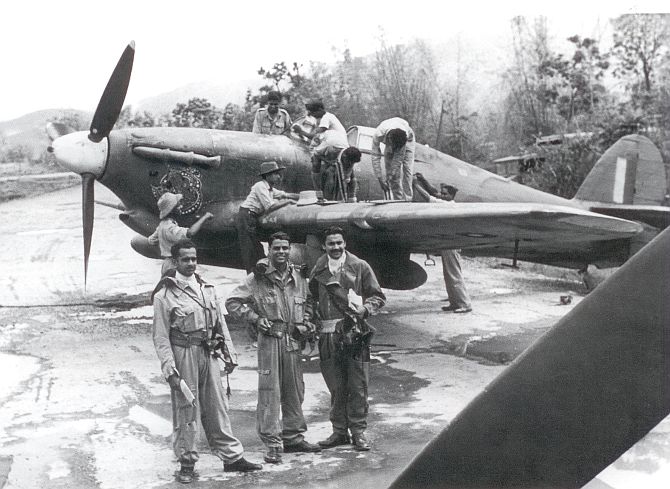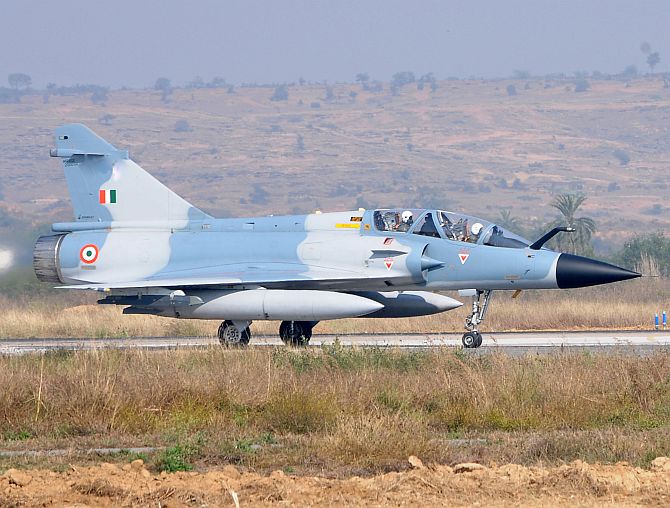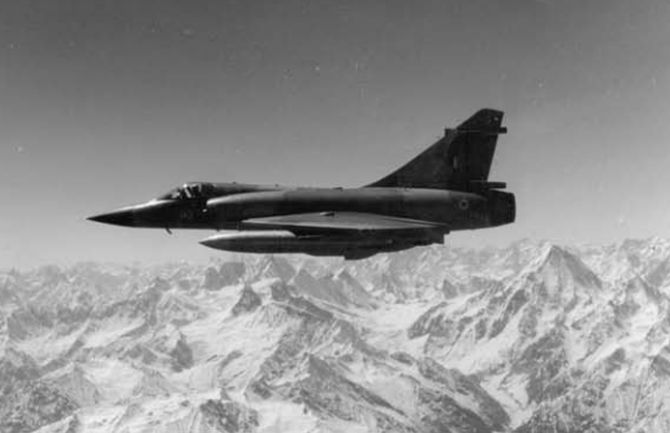Photographs: Courtesy, the Indian Air Force Air Vice Marshal Arjun Subramaniam
The No 1 Squadron, nicknamed The Tigers, is the oldest squadron of the Indian Air Force.
The squadron, which has seen action from the Second World War to the 1999 Kargil conflict with Pakistan, celebrates 80 years of its formation this year.
Air Vice Marshal Arjun Subramaniam, who has served twice with the squadron, looks back on the Tigers's awesome journey.
On a bright February 14 morning, the tarmac at Tigers den at the Air Force Station in Gwalior was bustling with activity as four generations from the No 1 Squadron, the Indian Air Force's oldest squadron, celebrated 80 years of dedicated service to the nation.
From the stark mountains of Waziristan where the squadron cut its teeth under the watchful eye of its first Indian Commanding Officer, Squadron Leader Subroto Mukherjee, to the jungles of Burma where it conducted counter-air and interdiction operations against the Japanese under Squadron Leaders Jumbo Majumdar and Arjan Singh, the Tigers have come a long way.
Today, it remains one of the IAF's premier squadrons, flying the first multi-role combat aircraft of the IAF -- the Mirage-2000.
Kindly ...
The IAF's Tigers roar into the 80s
Image: Flight Commander Squadron Leader Rajaram with pilots, technicians and a Hurricane during the Burma campaign in World War IIPhotographs: Courtesy, the No 1 Squadron Air Vice Marshal Arjun Subramaniam
Flying in the slow-moving Wapiti biplanes, Mukherjee led the Tigers into battle against tribals and insurgents in the North Western Frontier Province (currently the Khyber Pakhtunkhwa province in Pakistan) in what was really the first application of air power in sub-conventional warfare for the IAF.
'Jumbo' Majumdar, the second commanding officer, led the first counter-air mission by the IAF with a hastily-modified Lysander aircraft fitted with bombs against a Japanese airfield in Burma in 1942.
Arjan Singh then led the squadron, which by then had re-equipped with Hurricane fighters, in what were the first search and strike recce-cum-interdiction missions against advancing Japanese troops during the gallant defence of Kohima and Imphal in 1944.
It was Arjan Singh who alerted the army first of the presence of advance columns of Japanese troops as he spotted them along a crest line close to Imphal airfield while returning from a mission.
Kindly ...
The IAF's Tigers roar into the 80s
Image: A twin-seater Mirage-2000 at the Air Force Station in Gwalior.Photographs: Courtesy, the No 1 Squadron Air Vice Marshal Arjun Subramaniam
The first large formation of strike aircraft to hit Sargodha during the 1965 war with Pakistan comprised 12 Mystere jets from 1 Squadron operating from Adampur and led by the CO, Wing Commander O P Taneja.
It was during this mission that Squadron Leader Devayya shot down an F-104 Starfighter as he manoeuvred a crippled fighter in combat against a superior adversary before going down himself.
He was posthumously awarded the Mahavir Chakra decades later when the Pakistan Air Force pilot he shot down acknowledged his feat.
The 1971 war with Pakistan saw the Tigers in their MiG-21s back in action over Punjab as they carried out extensive combat air patrols and escorted Sukhoi-7 strikes against enemy armour in Shakargarh and other sectors.
The squadron was much decorated during the two wars with Pakistan, winning one Mahavir Chakra and four Vir Chakras.
Kindly ...
The IAF's Tigers roar into the 80s
Image: A Mirage 2000H on patrol mission during the Kargil conflict.Photographs: Courtesy, the Indian Air Force Air Vice Marshal Arjun Subramaniam
After an eventful period of a little more than two decades of flying the venerable MiG-21, the Tigers entered the digital age when they converted to the Mirage-2000 in 1986 along with No 7 Squadron, also known as the Battle Axes.
Since then the Tigers and Battle Axes have hunted together in various contingencies and conflicts and brought great laurels to the IAF.
The squadron was at the forefront of guarding the skies around Kargil from May to July 1999 during the conflict as the ground attack aircraft went about their task of pounding the occupied heights without any interference from the Pakistan Air Force.
The continuous presence of Mirages and Mig-29s in the area was a significant deterrent and one of the main reasons why the PAF was completely absent from the conflict.
The Tigers and the Battle Axes were joined at Gwalior in 2003 by a third squadron, the No 9 Squadron, also called the Wolfpack.
The Tigers along with the Battle Axes and Wolfpack have participated in the maximum number of international exercises with their counterparts in France, Singapore, South Africa, Britain and the United States.
Kindly ...
The IAF's Tigers roar into the 80s
Image: The legendary Marshal of the Air Force Arjan Singh, second from left, with Air Marshal Daljit Singh, left, and Wing Commander Pannu and Squadron Leader Kareem (right) at the Tigers's den at the Air Force Station in Gwalior.Photographs: Courtesy Indian Air Force Air Vice Marshal Arjun Subramaniam
Air combat tactics have seen revolutionary changes over the last two decades, driven primarily by advances in communications, networking, sensors and air-to-air missiles.
By virtue of the constant international exposure in recent years, the Tigers have contributed immensely to the development of the IAF's aerial war fighting techniques.
Amongst the distinguished IAF brass witnessing the February 14 event was a sprightly Marshal of the Air Force Arjan Singh, all of 95 years.
Also present on the occasion was the Commodore Commandant of 1 Squadron, Air Marshal Daljit Singh, who commanded the squadron between 1996 and 1998 and has probably spent the maximum time in the squadron over three tenures.
Representing the third generation of Tigers was the Commanding Officer of the squadron, Wing Commander Pannu.
Cutting their teeth in what is their first operational squadron were two young Flight Lieutenants, Joshi and Hooda, and Flying Officer Lather.
Completing the crowd were about 60 Tigers of various generations, including former IAF chief Air Chief Marshal A Y Tipnis.
Kindly ...
The IAF's Tigers roar into the 80s
Image: A twin-seater Mirage-2000 takes off from the Air Force Station in Gwalior.Photographs: Courtesy, the No 1 Squadron Air Vice Marshal Arjun Subramaniam
Excited to be back where all fighter pilots and squadron engineering officers love to be around; in the cockpit, on the tarmac or flight line, or in the crew room, there was nostalgia and bonhomie all around.
The Mirage-2000 is in the midst of a major upgrade, after which it will remain a frontline combat aircraft for at least the next two decades.
The upgrade will leave the aircraft unrecognisable to old timers, including those who first flew the Mirage-2000 in the mid-1980s.
The squadron has a formidable task in the years ahead -- it has a legacy to protect and nurture as it streaks towards the much coveted centenary.
From the Wapiti to the Mirage-2000, it has been a long journey. The history of the Tigers is, in fact, the history of the IAF!







article